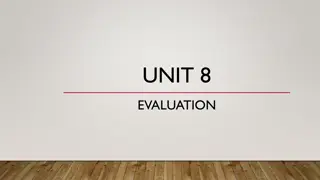Understanding the Value and Importance of Stakeholder Engagement in Evaluation
Exploring the concept of value in evaluation, this content delves into determining worth and quality through systematic processes. It highlights the significance of values in assessing success, discussing various methods for determining value and identifying criteria for evaluation. The activities and examples provided offer insights into what success looks like in evaluation processes.
Download Presentation

Please find below an Image/Link to download the presentation.
The content on the website is provided AS IS for your information and personal use only. It may not be sold, licensed, or shared on other websites without obtaining consent from the author. Download presentation by click this link. If you encounter any issues during the download, it is possible that the publisher has removed the file from their server.
E N D
Presentation Transcript
Determining value with stakeholders Dr Pauline Dickinson Dr Jeffery Adams Australasian Evaluation Society 2011 International Conference
Outline Value in evaluation Determining value Practice exercises Discussion
Evaluation It is the systematic determination of the quality or value of something (project, programmes, organisations) in order to take action
What is a value? The worth, desirability or utility of something A judgement of what is valuable or important The Concise Oxford Dictionary
Why values are important Help determine worth or quality How quality and success has been determined
Ways of determining value Review literature Stakeholder discussions Identifying effective ways of working Using expert judgement
What is valued? Establish criteria and standards Collect data Make evaluation judgement
What does success look like? Outcome: Increased awareness of the nutrient value of foods Evaluation Criteria (what will a successful outcome look like?) Key Sources of Data Method Ability to identify the main food groups Ability to state which foods are the best sources of certain key vitamins and minerals Ability to design a balanced nutritious meal using fresh ingredients Informal assessment of knowledge (by interview with a dietician ) Family self- assessment of nutritional knowledge (based on the listed criteria) Interview Questionnaire
What does success look like? Outcome:: Increased knowledge of how to grow fruit and vegetables Evaluation criteria Data source Method
Outcome: Increased awareness of the nutrient value of foods Rating Explanation (how you decide merit) All participants are able to identify the main food groups, state which foods are the best sources of certain key vitamins and minerals (e.g., iron, Vitamin C), and design a balanced, nutritious meal using fresh ingredients Excellent Most participants can do all of the above; most participants can design a reasonably nutritious meal, although they may not be able to explain which foods are high in key vitamins and minerals Very Good Over half of the participants can do all of the above and most of the participants can design a balanced, nutritious meal although they may not be able to explain which foods are high in key vitamins and minerals Good Most participants are unable to distinguish between healthy and unhealthy foods, and are not able to design a meal that meets minimum nutritional standards Poor
Outcome: Increased knowledge of how to grow fruit and vegetables Rating Explanation (how you decide merit) Excellent Very Good Good Poor
Contact details Pauline Dickinson p.m.dickinson@massey.ac.nz Jeffery Adams j.b.adams@massey.ac.nz SHORE and Whariki Research Centre Massey University Auckland, New Zealand www.shore.ac.nz
Acknowledgements and references Adams, J., & Dickinson, P. (2010). Evaluation training to build capability in the community and public health workforce. American Journal of Evaluation, 33(3), 421-433. Davidson, E. J. (2005). Evaluation methodology basics: The nuts and bolts of sound evaluation. Thousand Oaks: Sage. Fournier, D. M. (1995). Establishing evaluative conclusions: A distinction between general and working logic. New Directions for Evaluation, 1995(68), 15-32. House, E. R., and Howe, K. R. (1999). Values in evaluation and social research. Thousand Oaks: Sage.























